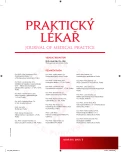Significance of the Cardio-Ankle Vascular Index (CAVI) measurement between sportsmen and physically inactive people
Authors:
Š. Urbánková 1; M. Frantisová 1; P. Dobšák 2
Authors‘ workplace:
Ústav preventivního lékařství LF MU, BrnoPřednosta: prof. MUDr. Zuzana Derflerová Brázdová, DrSc.
1; Fakultní nemocnice u sv. Anny v Brně a LF MU, BrnoKlinika tělovýchovného lékařství a rehabilitacePřednosta: prof. MUDr. Petr Dobšák, CSc.
2
Published in:
Prakt. Lék. 2013; 93(3): 110-113
Category:
Of different specialties
Overview
The Cardio-Ankle Vascular Index (CAVI) represents the extent of arterial stiffness, an increase in CAVI score reflects a progression of coronary artery disease. The biological age of a patient’s arteries should correspond to their actual age. If this is not the case, and biological age is overestimated, the probability of cardiovascular disease is increased.
Keywords:
CAVI index – arterial stiffness – cardiovascular diseases – blood pressure– arteriosclerosis
Sources
1. Schmidt-Trucksäss A, Weisser, B. Vascular aging, arterial hypertension and physical activity. Dtsch Med Wochenschr 2011; 136(46): 2367–2371.
2. Rooke T, Hirsch A, Misra S, et al. 2011 ACCF/AHA Focused Update of the Guideline for the Management of Patients With Peripheral Artery Disease (updating the 2005 guideline): a report of the American College of Cardiology Foundation/American Heart Association Task Force on Practice Guidelines. Society for Cardiovascular Angiography and Interventions; Society of Interventional Radiology; Society for Vascular Medicine; Society for Vascular Surgery. J Am Coll Cardiol 2011; 58(19): 2020–2045.
3. Ibata J, Sasaki, H, Kakimoto T, et al. Cardio-ankle vascular index measures arterial wall stiffness independent of blood pressure. Diabetes Res Clin Pract 2008; 80(2): 265–270.
4. Matuška J, Slováková K. Jak ovlivnit progresi tuhosti cévní stěny u diabetiků? Medical Tribune 2010, č. 12 [online]. Dostupný na WWW: http://www.tribune.cz/clanek/17795-jak-ovlivnit-progresi-tuhosti-cevni-steny-u-diabetiku [cit. 2012-03-15].
5. Shirai K, Hiruta N, Song M, et al. Cardio-ankle vascular index (CAVI) as a novel indicator of arterial stiffness: theory, evidence and perspectives. J Atheroscler Thromb 2011; 18(11): 924–938.
6. Takaki A, Ogawa H, Wakeyama T, et al. Cardio-ankle vascular index is a new noninvasive parameter of arterial stiffness. Circ J 2007; 71(11): 1710–1714.
7. Dobšák P, Sosíková M, Dušek L, a kol. Arterial stiffness in Czech population measured by VaSera 1500. Scripta Medica 2010; 84(2): 85–91.
8. Namekata T, Suzuki K, Ishizuka N, Shirai, K. Establishing baseline criteria of cardio-ankle vascular index as a new indicator of arteriosclerosis: a cross-sectional study. BMC Cardiovasc Disord 2011; 11(51), doi: 10.1186/1471-2261-11-51.
9. Shirai K, Hiruta N, Song M, et al. Cardio-ankle vascular index (CAVI) as a novel indicator of arterial stiffness: theory, evidence and perspectives. J Atheroscler Thromb 2011; 18(11): 924–928.
10. Schmidt-Trucksäss A, Weisser, B. komentář: Dobšák, P. Stárnutí cév, arteriální hypertenze a tělesná aktivita. Medicína po promoci 2012; 13(1): 46–52.
Labels
General practitioner for children and adolescents General practitioner for adultsArticle was published in
General Practitioner

2013 Issue 3
- Memantine Eases Daily Life for Patients and Caregivers
- Metamizole vs. Tramadol in Postoperative Analgesia
- Metamizole at a Glance and in Practice – Effective Non-Opioid Analgesic for All Ages
- Memantine in Dementia Therapy – Current Findings and Possible Future Applications
- What Effect Can Be Expected from Limosilactobacillus reuteri in Mucositis and Peri-Implantitis?
Most read in this issue
- Thymoma – a rare cause of pericardial effusion
- Quality of sleep, circadian preference and healthy life style in university students
- Pitfalls of cancer screening in general practice
- The evaluation of assessment tools for needs identification in family members in palliative care
